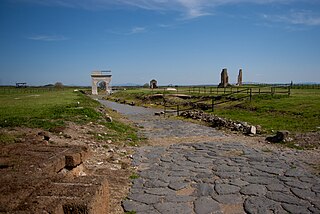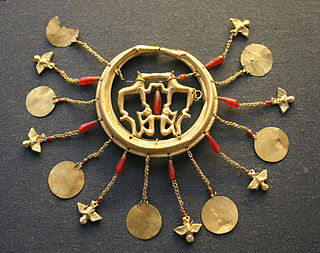
Jewellery consists of decorative items worn for personal adornment, such as brooches, rings, necklaces, earrings, pendants, bracelets, and cufflinks. Jewellery may be attached to the body or the clothes. From a western perspective, the term is restricted to durable ornaments, excluding flowers for example. For many centuries metal such as gold often combined with gemstones, has been the normal material for jewellery, but other materials such as glass, shells and other plant materials may be used.

Carnelian is a brownish-red mineral commonly used as a semiprecious stone. Similar to carnelian is sard, which is generally harder and darker; the difference is not rigidly defined, and the two names are often used interchangeably. Both carnelian and sard are varieties of the silica mineral chalcedony colored by impurities of iron oxide. The color can vary greatly, ranging from pale orange to an intense almost-black coloration. Significant localities include Yanacodo (Peru); Ratnapura ; and Thailand. It has been found in Indonesia, Brazil, India, Russia (Siberia), and Germany. In the United States, the official State Gem of Maryland is also a variety of carnelian called Patuxent River stone.

A necklace is an article of jewellery that is worn around the neck. Necklaces may have been one of the earliest types of adornment worn by humans. They often serve ceremonial, religious, magical, or funerary purposes and are also used as symbols of wealth and status, given that they are commonly made of precious metals and stones.

Puabi, also called Shubad or Shudi-Ad due to a misinterpretation by Sir Charles Leonard Woolley, was an important woman in the Sumerian city of Ur, during the First Dynasty of Ur. Commonly labeled as a "queen", her status is somewhat in dispute, although several cylinder seals in her tomb, labeled grave PG 800 at the Royal Cemetery at Ur, identify her by the title "nin" or "eresh", a Sumerian word denoting a queen or a priestess. Puabi's seal does not place her in relation to any king or husband, possibly indicating that she ruled in her own right. It has been suggested that she was the second wife of king Meskalamdug. Although little is known about Puabi's life, the discovery of Puabi's tomb and its death pit reveals important information as well as raises questions about Mesopotamian society and culture.

Ancient art refers to the many types of art produced by the advanced cultures of ancient societies with different forms of writing, such as those of ancient China, India, Mesopotamia, Persia, Palestine, Egypt, Greece, and Rome. The art of pre-literate societies is normally referred to as prehistoric art and is not covered here. Although some pre-Columbian cultures developed writing during the centuries before the arrival of Europeans, on grounds of dating these are covered at pre-Columbian art and articles such as Maya art, Aztec art, and Olmec art.

Ancient Egyptian art refers to art produced in ancient Egypt between the 6th millennium BC and the 4th century AD, spanning from Prehistoric Egypt until the Christianization of Roman Egypt. It includes paintings, sculptures, drawings on papyrus, faience, jewelry, ivories, architecture, and other art media. It was a conservative tradition whose style changed very little over time. Much of the surviving examples comes from tombs and monuments, giving insight into the ancient Egyptian afterlife beliefs.

An antefix is a vertical block which terminates and conceals the covering tiles of a tiled roof. It also serves to protect the join from the elements. In grand buildings, the face of each stone antefix was richly carved, often with the anthemion ornament. In less grand buildings moulded ceramic antefixes, usually terracotta, might be decorated with figures heads, either of humans, mythological creatures, or astrological iconography, especially in the Roman period. On temple roofs, maenads and satyrs were often alternated. The frightening features of the Gorgon, with its petrifying eyes and sharp teeth was also a popular motif to ward off evil. A Roman example from the Augustan period features the butting heads of two billy goats. It may have had special significance in imperial Rome since the constellation Capricorn was adopted by the emperor Augustus as his own lucky star sign and appeared on coins and legionary standards. By this time they were found on many large buildings, including private houses. The earliest examples in museum collections date back to the 7th century BCE in both Greece and Etruria.

Vulci or Volci was a rich Etruscan city in what is now northern Lazio, central Italy.
Jewelry of the Etruscan civilization existed in several eras.

Bucchero is a class of ceramics produced in central Italy by the region's pre-Roman Etruscan population. This Italian word is derived from the Latin poculum, a drinking-vessel, perhaps through the Spanish búcaro, or the Portuguese púcaro.

Menhet, Menwi and Merti, also spelled Manhata, Manuwai and Maruta, were three minor foreign-born wives of Pharaoh Thutmose III of the Eighteenth Dynasty. They are known for their lavishly furnished rock-cut tomb in Wady Gabbanat el-Qurud near Luxor, Egypt. They are suggested to be Syrian, as the names all fit into Canaanite name forms, although their ultimate origin is unknown. A West Semitic origin is likely, but both West Semitic and Hurrian derivations have been suggested for Menwi. Each of the wives bear the title of "king's wife", and were likely only minor members of the royal harem. It is not known if the women were related as the faces on the lids of their canopic jars are all different.

Scarabs are beetle-shaped amulets and impression seals which were widely popular throughout ancient Egypt. They still survive in large numbers today, and are popular among collectors of ancient artifacts. Through their inscriptions and typology, they prove to be an important source of information for archaeologists and historians of the ancient world, and represent a significant body of ancient Egyptian art.

Native American jewelry refers to items of personal adornment, whether for personal use, sale or as art; examples of which include necklaces, earrings, bracelets, rings and pins, as well as ketohs, wampum, and labrets, made by one of the Indigenous peoples of the United States. Native American jewelry normally reflects the cultural diversity and history of its makers, but tribal groups have often borrowed and copied designs and methods from other, neighboring tribes or nations with which they had trade, and this practice continues today. Native American tribes continue to develop distinct aesthetics rooted in their personal artistic visions and cultural traditions. Artists may create jewelry for adornment, ceremonies, and display, or for sale or trade. Lois Sherr Dubin writes, "[i]n the absence of written languages, adornment became an important element of Indian communication, conveying many levels of information." Later, jewelry and personal adornment "...signaled resistance to assimilation. It remains a major statement of tribal and individual identity."

The Aegina Treasure or Aigina Treasure is an important Minoan gold hoard said to have been found on the island of Aegina, Greece. Since 1892, it has been part of the British Museum's collection. It is one of the most important groups of Minoan jewellery.

The Isis Tomb is a richly endowed Etruscan chamber tomb that was found at the Polledrara Cemetery, Vulci, Lazio, Italy, in the early nineteenth century. Many artefacts were discovered in the Isis Tomb when it was originally excavated but, as was custom at the time, only objects of high monetary value were kept. Over 60 of these objects are now held by the British Museum, with others scattered across a range of museums around the world.

The Domagnano Treasure is an important Ostrogothic hoard found at Domagnano, Republic of San Marino in the late nineteenth century. The treasure is now divided among various institutions, including the Louvre Abu Dhabi, although the bulk of the hoard is currently held by the British Museum in London and the Germanisches Nationalmuseum in Nuremberg.

The Royal Cemetery at Ur is an archaeological site in modern-day Dhi Qar Governorate in southern Iraq. The initial excavations at Ur took place between 1922 and 1934 under the direction of Leonard Woolley in association with the British Museum and the University of Pennsylvania Museum of Archaeology and Anthropology in Philadelphia, Pennsylvania, United States.

Ancient Roman jewelry was characterized by an interest in colored gemstones and glass, in contrast with their Greek predecessors who focused primarily on the production of high-quality metalwork by practiced artisans. Extensive control of Mediterranean territories provided an abundance of natural resources to utilize in jewelry making. Participation in trade allowed access to both semi-precious and precious stones that traveled down the Persian Silk Road from the East.
The Castellani were a family of goldsmiths, collectors, antique dealers and potters who created a business "empire" active in Rome during the 18th and 19th centuries.

The Queens' Tombs at Nimrud are a set of four tombs discovered by Muzahim Hussein at the site of what was once the ancient Assyrian city of Nimrud. Once the capital of the Neo-Assyrian Empire, Nimrud was located on the East bank of the Tigris river, in what would be modern day Northern Iraq. Nimrud became the second capital of the Assyrian empire during the ninth century BCE, under Assurnasirpal II. Assurnasirpal II expanded the city and built one of the most significant architectural achievements at Nimrud, the Northwest Palace––bētānu in Assyrian. The palace was the first of many built by Neo-Assyrian rulers, and it became a template for later palaces. During an excavation of the Northwest Palace in 1988, the Queen's Tombs were discovered under the Southern, domestic wing. All four tombs discovered within the palace were built during the ninth and eighth centuries and were primarily constructed of the mudbrick, baked brick, and limestone ––materials commonly used in Mesopotamian architecture. The architecture of the tombs as well as the Northwest Palace within which they are housed provide historical insight into the Assyrian Empire's building techniques. The most notable items found within the queens' tombs included hundreds of pieces of fine jewelry, pottery, clothing, and tablets. These objects crafted by Neo-Assyrian artists would later allow archaeologists to build on their understanding of Neo-Assyrian goldsmithing techniques. Each tomb was built in advance of a queen's death and construction began as early as the 9th century under Assurnasirpal II and continued under Shalmaneser III.


















